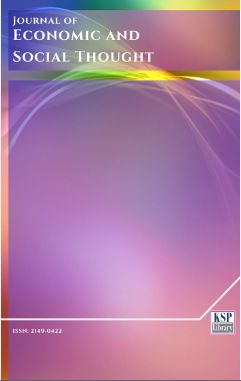Intrahousehold Bargaining, Domestic Violence Laws and Child Health Development in Ghana
Abstract
Abstract. I explore a unique exogenous instrument to examine how the intra-familial position of women influence health outcomes of their children using micro data from Ghana. Using the 2SLS-IV estimation technique, I build a model of household bargaining and child health development with perceptions of women regarding wife-beating and marital rape in the existence of domestic violence laws, in Ghana. Even though the initial OLS estimates suggest that women’s participation in decisions regarding purchases of household consumption goods help to improve child health outcomes, the IV estimates reveal that the presence of endogeneity underestimates the impact of women’s bargaining power on child health outcomes. Our choice of instrument is robust to endogeneity, father characteristics and residency robustness checks.
Keywords. Household Bargaining, Women Empowerment, Child Health Investment, Instrumental Variables, Domestic Violence.
JEL. J12, J13.
Keywords
References
Afridi, F., Mukhopadhyay, A., & Sahoo, S. (2012). Female labour force participation and child education in India: the effect of the national rural employment guarantee scheme. IZA DP, No.6593.
Agarwal, B. (1997). 'Bargaining' and gender relations: Within and beyond the household. Feminist Economics, 3(1), 1-51. doi. 10.1080/135457097338799
Anderson, S., & Eswaran, M. (2009). What determines female autonomy? Evidence from Bangladesh. Journal of Development Economics, 90(2), 179-191. doi. 10.1016/j.jdeveco.2008.10.004
Baden, S., Green, C., Otoo-Oyortey, N., & Peasgood, T. (1994). Background paper on gender issues in Ghana: Institute of Development Studies at the University of Sussex.
Bernal, R., & Keane, M. P. (2010). Quasi-structural estimation of a model of childcare choices and child cognitive ability production. Journal of Econometrics, 156(1), 164-189. doi. 10.1016/j.jeconom.2009.09.015
Blumberg, R. L. (1991). Income under female versus male control. in Gender, Family and the Economy: The Triple Overlap. (R. L. Blumberg, edt.) Chapter 4, doi. 10.4135/9781483325415.n5
Bourguignon, F., Browning, M., Chiappori, P.-A., & Lechene, V. (1993). Intra household allocation of consumption: A model and some evidence from French data. Annales d'Economie et de Statistique, 137-156.
Browning, M., Chiappori, P.-A., & Lechene, V. (2006). Collective and unitary models: A clarification. Review of Economics of the Household, 4(1), 5-14. doi. 10.1007/s11150-005-6694-2
Chiappori, P.-A. (1988). Nash-bargained households decisions: a comment. International Economic Review, 29(4), 791-796. doi. 10.2307/2526833
Dery, I., & Diedong, A. L. Domestic Violence against Women in Ghana: An Exploratory Study in Upper West Region, Ghana.
Desai, S., & Alva, S. (1998). Maternal education and child health: Is there a strong causal relationship? Demography, 35(1), 71-81. doi. 10.2307/3004028
Doss, C. R. (2001). Is Risk Fully Pooled within the Household? Evidence from Ghana. Economic Development and Cultural Change, 50(1), 101-130. doi. 10.1086/340009
Duflo, E., & Udry, C. (2004). Intrahousehold resource allocation in Cote d'Ivoire: Social norms, separate accounts and consumption choices. NBER, Working Paper, No.10498, doi. 10.3386/w10498
Elroy, M., & Horney, M. J. (1981). Nash Bargained Household Decisions. International Economic Review, 31(1), 237-242. doi. 10.2307/2526642
Fantahun, M., Berhane, Y., Wall, S., Byass, P., & Högberg, U. (2007). Women's involvement in household decision‐making and strengthening social capital—crucial factors for child survival in Ethiopia. Acta paediatrica, 96(4), 582-589.
Friedemann-Sánchez, G. (2006). Assets in intrahousehold bargaining among women workers in Colombia's cut-flower industry. Feminist Economics, 12(1-2), 247-269. doi. 10.1080/13545700500508551
GSS, G., & Macro, I. (2009). Ghana demographic and health survey 2008. Accra, Ghana: Ghana Statistical Service, Ghana Health Service, and ICF Macro.
Haddad, L., Hoddinott, J., & Alderman, H. (1997). Intrahousehold resource allocation in developing countries: models, methods, and policy: Johns Hopkins University Press.
Kishor, S. (2000). Empowerment of women in Egypt and links to the survival and health of their infants. in Women's Empowerment and Demographic Processes: Moving Beyond Cairo, (ed. H. Presser & G. Sen), New York: Oxford University Press.
Lépine, A., & Strobl, E. (2013). The effect of women’s bargaining power on child nutrition in rural Senegal. World Development, 45, 17-30. doi. 10.1016/j.worlddev.2012.12.018
Li, L., & Wu, X. (2011). Gender of children, bargaining power, and intrahousehold resource allocation in China. Journal of Human Resources, 46(2), 295-316.
Lundberg, S., & Pollak, R. A. (1993). Separate spheres bargaining and the marriage market. Journal of Political Economy, 101(6), 988-1010.
Manser, M., & Brown, M. (1980). Marriage and household decision-making: A bargaining analysis. International Economic Review, 21(1), 31-44. doi. 10.2307/2526238
Promoting Gender Equality (2013, September). Retrieved from www.unfpa.org:
Quisumbing, A. R., & Maluccio, J. A. (2000). Intrahousehold allocation and gender relations: New empirical evidence from four developing countries: International Food Policy Research Institute Washington, DC.
Schultz, T. P. (1990). Testing the neoclassical model of family labor supply and fertility. Journal of Human Resources, 25(4), 599-634. doi. 10.2307/145669
Smith, L. C. (2003). The importance of women's status for child nutrition in developing countries (Vol. 131): Intl Food Policy Res Inst.
Smith, L. C., & Haddad, L. J. (2000). Explaining child malnutrition in developing countries: A cross-country analysis (Vol. 111): Intl Food Policy Res Inst.
Thomas, D. (1990). Intra-household resource allocation: An inferential approach. Journal of Human Resources, 25(4), 635-664. doi. 10.2307/145670
Thomas, D. (1997). Incomes, expenditures, and health outcomes: Evidence on intrahousehold resource allocation. in Intrahousehold Resource Allocation in Developing Countries, (edt. L. Haddad, J. Hoddinott, H. Alderman), p.142-164.
Udry, C. (1996). Gender, agricultural production, and the theory of the household. Journal of Political Economy, 104(6), 1010-1046.
Ueyama, M. (2006). Effects of Women’s Agriculture on Child Health in Rural Malawi:" Food Security Effect” and “Bargaining Effect. Japan Society for the Promotion of Science, Hitotsuashi University.
Ulph, D. (1989). A general non-cooperative Nash model of household consumption behaviour: Johann Wolfgang Goethe-Universität Frankfurt.
Vermeulen, F. (2002). Collective household models: principles and main results. Journal of Economic Surveys, 16(4), 533-564. doi. 10.1111/1467-6419.00177
World Bank (2011) ‘Gender Action Plan: Gender Equality as Smart Economics”, A World Bank Report
World Bank (2012), Promoting Women’s Agency in the ‘World Development Report 2012: Gender Equality and Development,
DOI: http://dx.doi.org/10.1453/jest.v3i1.621
Refbacks
- There are currently no refbacks.
Journal of Economic and Social Thought - J. Econ. Soc. Thoug. - JEST - www.kspjournals.org
ISSN: 2149-0422
Editor: jest@ksplibrary.org Secretarial: secretarial@ksplibrary.org Istanbul - Turkey.
Copyright © KSP Library




